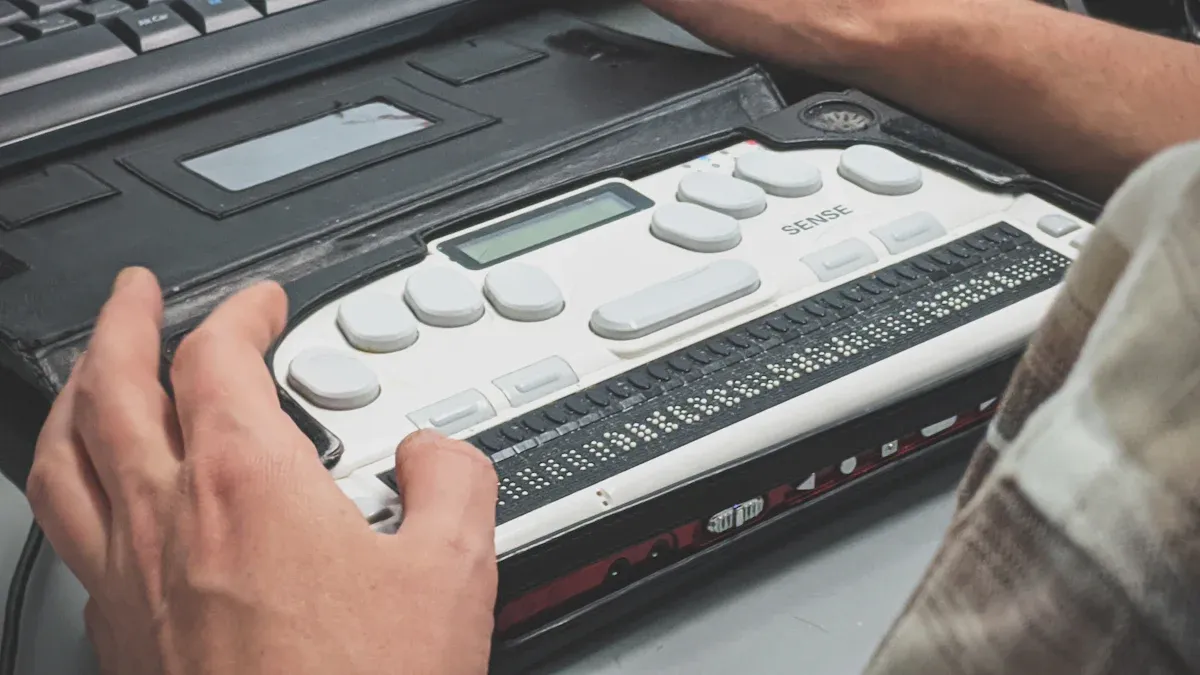
Industrial Braille Keypad technology helps organizations meet accessibility compliance. People with visual impairments can access equipment safely and independently. > Meeting legal and ethical obligations shows a company values inclusivity. Organizations reduce legal risks when they prioritize accessible solutions.
Key Takeaways
- Industrial Braille Keypads help organizations meet legal accessibility requirements and reduce risks like lawsuits and fines.
- These keypads improve safety and independence for people with visual impairments by providing clear tactile feedback and easy-to-use designs.
- Upgrading to accessible keypads and training staff shows a company’s commitment to inclusivity and builds trust with customers and employees.
Industrial Braille Keypad and Legal Requirements
Equal Access and Regulatory Mandates
Government agencies and industry regulators require organizations to provide equal access for all users. Laws such as the Americans with Disabilities Act (ADA) and Section 508 set clear rules. These rules state that people with disabilities must have the same opportunities as everyone else. Industrial Braille Keypad solutions help companies meet these requirements. They allow people with visual impairments to use machines and equipment safely.
Note: Equal access is not just a suggestion. It is a legal mandate that organizations must follow.
Many industries, including manufacturing and transportation, must install accessible keypads. These devices support independence and safety for all users. When companies use Industrial Braille Keypad technology, they show respect for every individual.
Legal Risks of Non-Compliance
Failure to meet accessibility standards can lead to serious legal problems. Organizations may face lawsuits, fines, or government investigations. Courts have ruled in favor of individuals who could not access essential services due to a lack of accessible equipment.
A few common legal risks include:
- Discrimination lawsuits from individuals with disabilities
- Penalties from regulatory agencies
- Loss of government contracts
| Risk Type | Possible Consequence |
|---|---|
| Lawsuit | Financial damages |
| Regulatory penalty | Fines or sanctions |
| Contract loss | Missed business opportunities |
Industrial Braille Keypad solutions help reduce these risks. By following the law, companies protect themselves and their reputation.
Corporate Responsibility in Accessibility
Companies have a duty to create inclusive environments. This responsibility goes beyond legal compliance. It reflects a commitment to social values and ethical business practices. When organizations install Industrial Braille Keypad devices, they show leadership in accessibility.
Tip: Investing in accessibility can improve a company’s public image and attract more customers.
Many businesses now include accessibility in their core values. They train staff, update equipment, and seek feedback from users. These actions help build trust with employees, customers, and the community.
Industrial Braille Keypad and Accessibility Standards
ADA and Section 508 Compliance
The Americans with Disabilities Act (ADA) and Section 508 set the foundation for accessibility in the United States. These laws require that electronic and information technology remain accessible to people with disabilities. Industrial Braille Keypad devices help organizations meet these standards. ADA guidelines specify tactile features and clear labeling. Section 508 focuses on federal agencies and their contractors. Both laws encourage the use of Braille and tactile markings on keypads. Companies that follow these rules show respect for all users.
Note: ADA and Section 508 compliance is not optional for many organizations. It is a legal requirement.
International Standards and Best Practices
Countries outside the United States also set accessibility standards. The European Union uses EN 301 549, which covers ICT accessibility. Australia and Canada have their own regulations. Many organizations follow ISO standards for tactile and Braille markings. Best practices include regular testing and feedback from users with visual impairments. These steps ensure that keypads work well in real-world settings.
| Region | Standard/Guideline |
|---|---|
| United States | ADA, Section 508 |
| European Union | EN 301 549 |
| Global | ISO Standards |
Industry-Specific Guidelines
Different industries may have unique requirements. Transportation, healthcare, and manufacturing often need specialized keypad layouts. Some sectors require extra security or privacy features. Organizations should review industry guidelines before choosing a keypad solution. This approach ensures that every Industrial Braille Keypad meets both legal and practical needs.
Key Features of Industrial Braille Keypad Design

Tactile and Braille Markings
Tactile and Braille markings help users with visual impairments identify keys quickly. Raised dots and symbols provide clear feedback under the fingers. Many Industrial Braille Keypad models use durable materials for these markings. This ensures the symbols stay readable even after heavy use. Some keypads also include high-contrast colors to help users with low vision.
Note: Consistent tactile markings make it easier for users to learn and remember keypad layouts.
Key Arrangement and Usability
Key arrangement affects how easily a person can use the keypad. Designers often use logical layouts, such as standard number pads or grouped function keys. This helps users find the right button without confusion. Large, well-spaced keys reduce the chance of pressing the wrong button. Some Industrial Braille Keypad designs include audio feedback, which confirms each key press.
- Logical key grouping
- Large, spaced keys
- Audio or vibration feedback
Privacy and Security Features
Privacy and security matter in many industrial settings. Some keypads use shielded designs to block others from seeing key presses. Others include features like timed lockouts or password protection. These measures help protect sensitive information and prevent unauthorized access.
| Feature | Benefit |
|---|---|
| Shielded key layout | Prevents shoulder surfing |
| Timed lockout | Stops repeated attempts |
| Password protection | Secures user access |
A well-designed Industrial Braille Keypad supports both accessibility and security needs.
Trends in Industrial Braille Keypad Technology for 2025

Integration with Digital and Mobile Interfaces
Manufacturers now design keypads that connect with digital systems. Many new models support Bluetooth or Wi-Fi. These features allow users to control machines from smartphones or tablets. Workers can receive real-time feedback on their devices. This integration helps people with visual impairments use equipment more easily. Some systems even send alerts or instructions to mobile apps.
Tip: Digital integration can reduce training time for new users.
Durability and Customization for Industrial Use
Industrial environments require tough equipment. Companies use materials like stainless steel or reinforced plastics for keypads. These materials resist water, dust, and chemicals. Customization options let organizations choose layouts that fit their needs. Some keypads offer interchangeable keycaps or programmable functions. This flexibility supports different industries, from manufacturing to healthcare.
| Feature | Benefit |
|---|---|
| Reinforced casing | Withstands heavy use |
| Custom layouts | Fits unique workflows |
| Sealed design | Blocks moisture |
AI-Powered and Smart Accessibility Solutions
Artificial intelligence now plays a role in accessibility. Some keypads use AI to learn user habits. These systems can adjust feedback based on user preferences. For example, a keypad might increase vibration for someone with low sensitivity. Smart solutions also include voice prompts and error detection. These features help users avoid mistakes and improve safety.
Note: AI-powered keypads can adapt to each user, making technology more inclusive.
Implementing Industrial Braille Keypad Solutions
Assessing Current Accessibility Measures
Organizations should start by reviewing their current accessibility features. They can walk through facilities and test equipment from the perspective of a person with visual impairments. This process helps identify barriers that prevent equal access. Many companies use checklists or accessibility audits to guide this review. Feedback from employees and visitors with disabilities provides valuable insights.
Tip: Regular assessments help organizations stay compliant as standards evolve.
Upgrading and Retrofitting Existing Systems
Many facilities have older equipment that does not meet modern accessibility standards. Upgrading these systems often costs less than full replacement. Companies can retrofit keypads with tactile or Braille markings. Some manufacturers offer kits that fit over existing buttons. When selecting upgrades, organizations should consider durability and compatibility with current technology.
A simple upgrade process might include:
- Identifying non-compliant keypads.
- Choosing retrofit solutions.
- Scheduling installation during low-traffic hours.
- Testing new features with users.
Staff Training and User Support
Staff play a key role in supporting accessibility. Training programs teach employees how to assist users with disabilities. These sessions cover proper communication and how to demonstrate accessible features. Companies should provide clear instructions and support materials for all users.
| Training Focus | Benefit |
|---|---|
| Communication skills | Better user experience |
| Equipment demos | Increased confidence |
| Troubleshooting | Faster problem-solving |
A well-trained team ensures everyone can use equipment safely and independently.
Risks and Benefits of Accessibility Compliance
Legal and Financial Implications
Organizations that ignore accessibility rules face real risks. Lawsuits can lead to large fines and legal fees. Some companies lose contracts or government funding if they do not follow accessibility laws. Insurance costs may rise after a violation. A simple checklist can help leaders track these risks:
- Lawsuit settlements
- Regulatory fines
- Lost business opportunities
- Higher insurance premiums
Note: Staying compliant protects a company’s finances and keeps operations running smoothly.
Business and Reputational Advantages
Companies that invest in accessibility often see strong business results. Customers trust brands that care about everyone. Employees feel proud to work for inclusive organizations. Good accessibility can open new markets and attract more clients. A positive reputation helps a company stand out from competitors.
| Advantage | Impact |
|---|---|
| Customer loyalty | Repeat business |
| Brand trust | Strong public image |
| Market growth | New opportunities |
Enhancing User Experience and Inclusivity
Accessible equipment makes life easier for everyone. People with disabilities can use machines safely and independently. Clear instructions and helpful features reduce mistakes. Teams that focus on inclusivity create better products for all users.
Tip: Listening to user feedback leads to smarter design choices and happier customers.
Industrial Braille Keypad solutions help organizations create accessible spaces. Proactive upgrades reduce legal risks and build trust. Regular reviews keep accessibility measures effective.
Companies that prioritize accessibility show leadership and care for every user.
FAQ
What industries use industrial Braille keypads?
Manufacturing, transportation, healthcare, and public facilities often use industrial Braille keypads. These sectors require accessible equipment for employees and visitors with visual impairments.
How do Braille keypads improve safety?
Braille keypads help users identify controls quickly. This reduces mistakes and accidents. Clear tactile feedback ensures people with visual impairments operate equipment safely.
Are industrial Braille keypads difficult to install?
Most manufacturers design Braille keypads for easy installation. Many models fit over existing panels. Companies can upgrade equipment without major changes.
Tip: Always follow the manufacturer’s instructions for best results.


